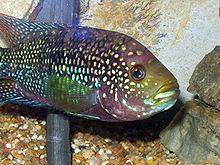- Jack Dempsey (fish)
-
Jack Dempsey 
Scientific classification Kingdom: Animalia Phylum: Chordata Class: Actinopterygii Order: Perciformes Family: Cichlidae Subfamily: Cichlasomatinae Genus: Rocio Species: R. octofasciata Binomial name Rocio octofasciata
(Regan, 1903)- For other uses see Jack Dempsey (disambiguation).
The Jack Dempsey (Rocio octofasciata (Regan, 1903), formerly Nandopsis octofasciatum and Cichlasoma octofasciatum) is a cichlid fish that is widely distributed across North and Central America (from Mexico south to Honduras).[1][2][3] Its common name refers to its aggressive nature and strong facial features, likened to that of the famous 1920s boxer Jack Dempsey.[citation needed]
Contents
Distribution
The fish is native to Mexico and Honduras,[1] where it is found in slow-moving waters, such as swampy areas with warm, murky water, weedy, mud- and sand-bottomed canals, drainage ditches, and rivers.[2] It is also established as an introduced species in Australia, the USA and Thailand (presumably as an aquarium escapee).[4]
Ecology
The Jack Dempsey natively lives in a tropical climate and prefers water with a pH of 6-7, a water hardness of 9–20 dGH, and a temperature range of 22–30 °C (72–86 °F). It can reach up to 25 cm (10 in) in length. It is carnivorous, eating worms, crustaceans, insects and other fish. It can eat small/young platies when it is three inches long.[2]
Reproduction
Jack Dempseys lay their eggs on the substrate (the bottom of the aquarium or pool). Like most cichlids, they show substantial parental care: both parents help incubate the eggs and guard the fry when they hatch. Jack Dempseys are known to be attentive parents, pre-chewing food to feed to their offspring. However, it is not uncommon for them to eat their fry when the breeding pair are overly disturbed or something in their environment is wrong.
Morphology
The coloration changes as the fish matures from a light gray or tan with faint turquoise flecks to a dark purple-gray with very bright, iridescent blue, green, and gold flecks. Their colors change under stress. The dorsal and anal fins of mature males have long, pointed tips. Females lack these exaggerated tips.
In the aquarium
The fish is a popular aquarium fish, due to its striking appearance and personable mannerisms. It, like most cichlids, is considered "aggressive", but can get along in a well-populated tank, tending to be more territorial if kept with only a few other fish, therefore allowed to easily establish and defend a "territory" in the tank. Jack Dempsey cichlids can often appear shy, hiding away in cave work. It is recommended that the Jack Dempsey cichlid is provided with plenty of places to hide. They will often claim a cave first and be very aggressive to other tank mates that swim near its home. There is also a blue variant of this fish which commonly known as the blue jack dempsey or electric blue jack dempsey. This is natural genetic mutation. The blue counterpart is less aggressive, smaller in size and more delicate. Sometimes you will change Jack Dempsey's tank, and the fish, within the first day or so, will have a pail color to it. Make sure not to confuse this with a illness of some sort.
Trivia
In 1997 the San Francisco Chronicle reported that a man had died when he put a Jack Dempsey into his mouth as a joke: the fish presumably erected its fin spines to avoid being swallowed, a characteristic cichlid anti-predator response, and became wedged in the man's throat.[5]
In a second season episode of Homicide: Life on the Street, a Jack Dempsey is recovered at the scene of a murder, and is taken home by an unsuspecting Detective John Munch, who intends to give it to his tropical fish-collecting girlfriend as a present. As a surprise, he places the fish in her aquarium, where it proceeds to devour $4,000 worth of her fish. Munch later refers to the fish as an "assassin" who "uses piranhas as toothpicks."
See also
References
- ^ a b "Convict and Jack Dempsey placed in new genera". Archived from the original on 2007-12-28. http://web.archive.org/web/20071228234519/http://www.practicalfishkeeping.co.uk/pfk/pages/item.php?news=1399. Retrieved 2008-06-27.
- ^ a b c Froese, Rainer, and Daniel Pauly, eds. (2005). "Cichlasoma octofasciatum" in FishBase. May 2005 version.
- ^ "Cichlasoma octofasciatum". Integrated Taxonomic Information System. http://www.itis.gov/servlet/SingleRpt/SingleRpt?search_topic=TSN&search_value=169779. Retrieved June 22, 2005.
- ^ "Countries where Cichlasoma octofasciatum is found". Fishbase. January 2007. http://www.fishbase.org/Country/CountryList.cfm?ID=3616&GenusName=Cichlasoma&SpeciesName=octofasciatum. Retrieved 2007-06-27.
- ^ Barlow, G. W. (2000). The Ciidge MA: Perseus
Categories:- Jack Dempsey
- Cichlasomatinae
- Animals described in 1903
Wikimedia Foundation. 2010.

